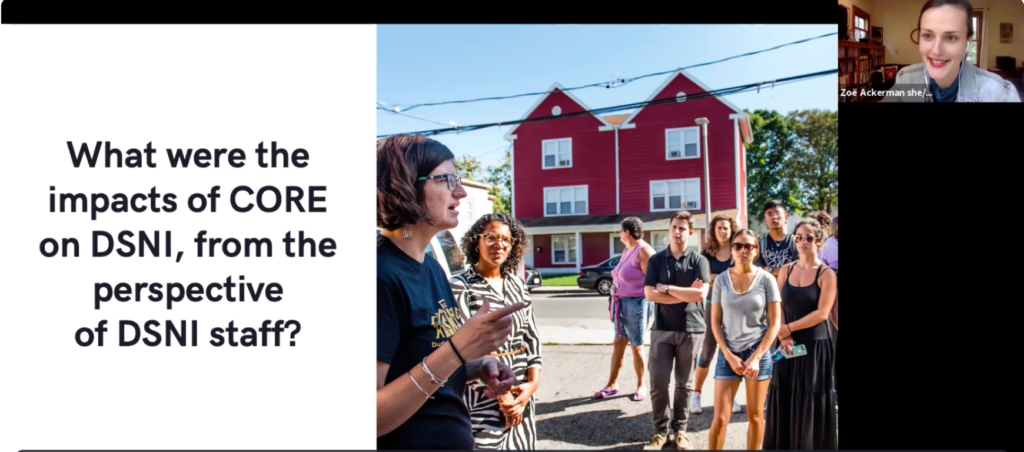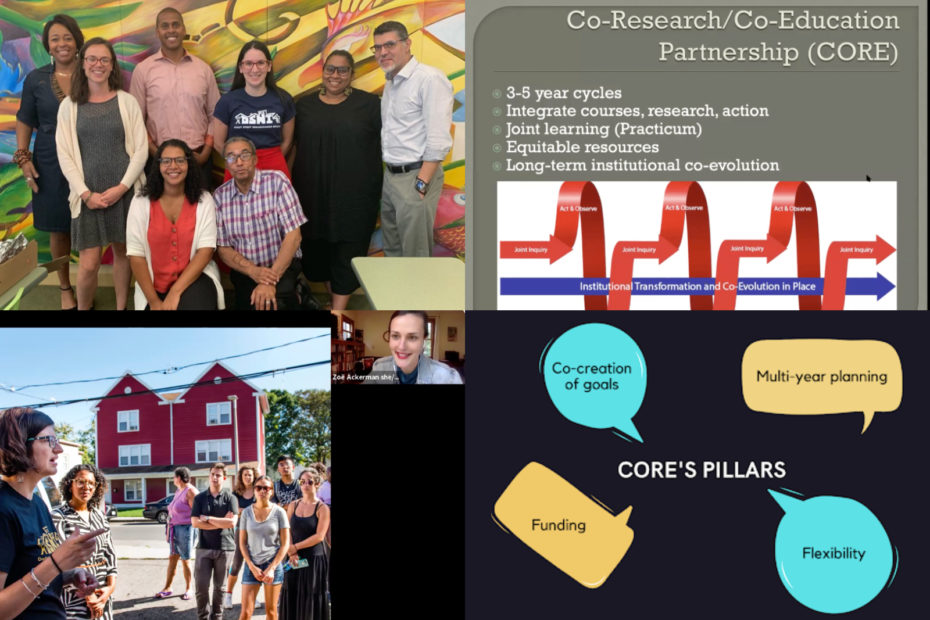This guest post was first published on Professor Penn Loh’s blog, also called Practical Visionaries. Read the original article, posted on May 26, 2020, here.
On Tuesday, May 5th, over 60 educators, community members, and students gathered digitally for a symposium called “Deepening Community-University Partnerships.” The event provided a moment for reflection and celebration about Co-Research/Co-Education (CORE), an innovative, multi-year, community-based collaboration for teaching, research, and practice. This year, CORE completed its first three-year partnership with Dudley Street Neighborhood Initiative (DSNI).

Dean Alan Solomont, of The Jonathan M. Tisch College of Civic Life, and Mary Davis, Chair of the Department of Urban & Environmental Policy & Planning (UEP), helped open the session. Tisch College and UEP are the chief sponsors of CORE at of Tufts. The symposium featured a panel with three speakers: Harry Smith, former Director of Sustainable Economic Development at DSNI; Joceline Fidalgo, Deputy Director at DSNI and Masters Candidate in Public Policy at Tufts UEP; and Minnie McMahon, UEP alumna and Project and Operations Manager at Dudley Neighbors, Inc. (DNI). Zoë Ackerman, a recent UEP graduate and CORE Research Assistant, also presented her evaluation of the impact of the CORE program on DSNI. Tisch Associate Dean Diane Ryan closed the session with some thoughts on how to build on the CORE model across Tufts.

Over the course of the afternoon, we discussed a range of approaches to community-university partnerships. At their worst, they are transactional relationships where students drop into an organization for a brief semester to gain knowledge and skills. Staff become burdened with creating and managing projects for the student’s benefit, and then the organization never hears from the student again.
We then grappled with questions like: What opportunities can arise from universities letting go of a predetermined research agenda to engage in joint inquiry in community? How can universities act in solidarity with the communities within which they reside?
CORE strives for deeper, more equitable transformative relationships between community and university that can overcome the typical challenges of working around semester schedules and a narrow focus on the learning needs of students and the agendas of researchers.
The session highlighted that CORE increases community-university solidarity by creating space for students and practitioners to build relationships based on shared values, and providing multiple opportunities to learn and create knowledge together. These relationships, bolstered by Tufts’s long-term commitment to DSNI, can produce transformative learning experiences, make the university more accessible to community organizations, and leverage institutional resources to advance strategies for community control.
In her assessment of CORE, Zoë highlighted the four major values and practices that make CORE replicable: co-creation of goals; sharing resources and funding; flexibility; and multi year planning, which will be discussed in further detail below.

Transformative Learning Experiences
The relationships between UEP students and DSNI have generally been founded on shared values of centering local knowledge and prioritizing community control. As a result, the project design processes are collaborative, guided by a commitment to matching students’ skills and learning objectives with issues that DSNI is currently grappling with. This process requires flexibility from the university, and a willingness to understand that staff capacity and organizational priorities may need to shift.
Zoë’s evaluation revealed that CORE, as a program, is “more than just the sum of its parts.” Because CORE projects are intentionally strung together over several years, one CORE assessment interviewee said, DSNI can “build capacity to strategically work towards its own goals.” Over the course of three years, CORE used every semester and summer as an opportunity for students and DSNI staff to learn and produce knowledge together, whether through classes like the Community Practicum, Field Projects and Teaching Democracy, an internship as a Tisch Summer Fellow, or in thesis projects. This continuity gives students opportunities to engage with DSNI for more than just one semester, with some lasting more than two years. The long-term engagement also meant that DSNI could trust that the process was mutually beneficial, with continuity among students, and quality work that could contribute to their organizing efforts.
Panelists expressed that the added research capacity from Tufts UEP increased legitimacy and visibility for their campaigns around community land trusts and a recent partnership with the City of Boston around the Upham’s Corner Implementation process. Student teams documented community engagement processes and provided space for reflection that enhanced DSNI’s work, and provided rich learning experiences for students that tied directly to their professional goals.

Some of CORE’s outcomes are illustrated on the right:
Advancing Community Control
In her evaluation, Zoë defined CORE as: “an institutionalized set of commitments and programs, built on a foundation of trust and relationships, that aims to provide strategic capacity to support democratically-controlled movements in Boston and beyond.” I see this as an articulation of UEP students taking on “accompanier” roles: deciding that they will work together with community partners toward shared goals. Being an accompanier also means that people with access to power (in this case, access to a university’s resources) understand their responsibility to leverage their positionality to build capacity and provide additional resources to marginalized groups (in this case the community that DSNI works within). CORE has done this by acquiring funding to compensate DSNI staff for taking on the extra work of partnering with a university, collaboratively writing grant proposals, and facilitating research processes that support DSNI’s movements.
Of course, facilitating community-university solidarity is complex. Relationships take time and commitment to build. It’s easy for students and faculty to get caught in the machinery of academia and lose track of those relationships. Questions about the challenges of implementing projects on a semester timeline, the accessibility of Tufts as a larger institution, and how to make continuity among students stronger, still linger.
The panelists and Zoë all highlighted the necessity of having Penn mediate plans and expectations for both the community and student partners. Having a written MOU where goals were explicitly stated on paper for all parties to come back to really facilitated that process. Continuity among students could potentially be made stronger through implementing a cohort model, in which second year students on-board first year students into the program and introduce them to the community partner, as well as create opportunities for the cohort to come together to brainstorm and problem solve on their own. Hiring a year-long fellow could also alleviate the burden of student turnover on a semester basis.
The session also grappled with how CORE’s values and commitments can take root at other institutions, in their specific contexts. If you are interested in working in solidarity with your community from your position at a university, here are some questions to begin asking:
- What are my department/institution’s explicit and implicit values? How do they align with my personal values and where are there gaps? How can shared values guide my department/institution’s relationship building with community members and organizations?
- What is my department/institution’s process for developing projects for students and community partners? Whose needs and knowledge are centered? Whose skills are considered?
- How will we compensate community partners for their time?
- Find out: What do we want to do together? What types of partnerships, and what types of spaces, are we trying to build together?
